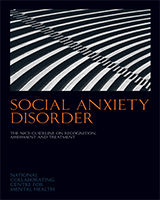From: 8, COMPUTERISED COGNITIVE BEHAVIOURAL THERAPY FOR SPECIFIC PHOBIAS IN ADULTS

Social Anxiety Disorder: Recognition, Assessment and Treatment.
NICE Clinical Guidelines, No. 159.
National Collaborating Centre for Mental Health (UK).
Leicester (UK): British Psychological Society (UK); 2013.
Copyright © The British Psychological Society & The Royal College of Psychiatrists, 2013.
All rights reserved. No part of this book may be reprinted or reproduced or utilised in any form or by any electronic, mechanical, or other means, now known or hereafter invented, including photocopying and recording, or in any information storage or retrieval system, without permission in writing from the publishers. Enquiries in this regard should be directed to the British Psychological Society.
NCBI Bookshelf. A service of the National Library of Medicine, National Institutes of Health.